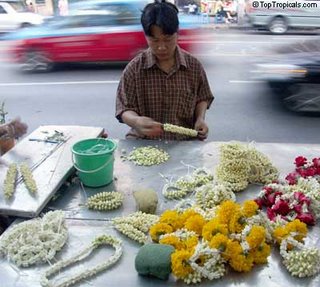
Prairial 26 Jasmine (Jasmin)
If I could live my life surrounded entirely by fragrant flowers, I would. But which would I choose if I could only choose one? The iris? Roses? Lily of the valley? Linden flowers? Elder flowers? Daphne odora? Sweet box? Honeysuckle? Lilac? Or jasmine? I think I would choose the iris, but jasmine would come in a close second.
To my delight, one of my neighbors has planted a jasmine up against the white column at the entrance to our Federal-looking brick apartment building, built in 1910, here on the top of Capitol Hill in Seattle. So during the summer as I come in or go out of the building, I catch a whiff of that heavenly aroma.
It is said that white jasmine was first brought back to Europe from India in the sixteenth century by Vasco da Gama, the Portugese merchant and explorer who established himself in Calcutta. In India, it is called the “Queen of Flowers.” The name jasmine comes from the Persian word for “white flower.”
Martin calls Jasmine officinale, the poet’s jasmine. Jeanne Rose says that Jasmine odoratissiumum is the only jasmine that retains its scent when dried. But is is from Jasminum officinale that the oil of jasmine is obtained through enfleurage (steeping the flowers in olive oil or lard). This oil is one of the most expensive scents in the world. Rose says it is an aphrodisiac, whether added to massage oil to rub on the body or inhaled.
Mandy Aftel in her wonderful book on perfume says that the magic ingredient that makes the scent of jasmine so desirable is indol, which is also found in human feces. She quotes chemist and perfume writer Paul Jellinek who writes: “It is precisely the odor of indol, reminiscent of decay and feces, that lends orange blossom, jasmine, tuberose, lilac and other blossoms that putrid-sweet, sultry-intoxicating nuance which has led to the sum of these flowers and of their extracts as delicate aphrodisiacs, today as in the past.”
In the “Gamut of Odors” developed by Septimus Piesse in 1867, Jasmine is a high C. And there is an ancient Chinese love song called “Jasmine Blossom.” A Chinese song with a similar theme, “What a Beautiful Jasmine Blossom,” was copied by Puccini when he was composing Turandot.
Scoble and Field say Jasmine is an emblem of good luck and increase worn by Italian brides on their wedding day. They tell the story of a servant working for the Medici family who stole a branch of jasmine to give to his bride (the Duke was so proud of his plant he forbade anyone to remove even a leaf from his garden). The couple were able to grow many plants from this one purloined cutting, and became rich as a result.

Jasminum sambac (or Arabian jasmine) is worn at weddings in Java and in the Philippines. It is the national flower of Indonesia, the Philippines and Pakistan. In Hawaii it is known as pikake. It is the jasmine used in making jasmine tea (which is said to have spiritual qualities)—the jasmine flowers are placed alongside tea leaves which absorb the odor of the jasmine. For a thorough view of jasmine’s importance and uses in food, ritual and medicine in India and the Philippines, see this article by Mike at Top Tropicals:
http://www.toptropicals.com/html/toptropicals/articles/shrubs/jasmin_facts.htm
I love the aristorcratic names of the varieties of jasminum sambac: The Grand Duke of Tuscany, the Maid of Orleans and the Belle of India.
References:
Aftel, Mandy, Essence and Alchemy, Gibbs Smith 2004
Martin, Laura, Garden Flower Folklore, Globe Pequot Press 1987
Rose, Jeanne, Herbs & Things, Grosset and Dunlap 1972
Scoble, Gretchen and Ann Field, The Meaning of Flowers; Myth Language and Lore, Chronicle
For everything you want to know about jasmine, see the inestimable Mrs. M Grieve
http://botanical.com/botanical/mgmh/j/jasmin06.html
Names of varieties from:
http://www.desert-tropicals.com/Plants/Oleaceae/Jasminum_sambac.html
For an article on Chinese songs about jasmine:
http://chinesemusic.net/feature_jasmine_blossom.php
3 comments:
I so wish the climate here was mild enough to grow jasmine. Much as I enjoy living up here in the north, it would be a rare treat to be able to grow jasmine outside (and more of the old roses too.)
Waverly, I'm really enjoying your new blog! Jasmine is one of my favorites also. I have the "regular" kind and a special one that is about 100 years old, came over from Sicily with my GreatGrandma Zaccone. Since I've had this cutting, it hasn't bloomed yet, but I'm not giving up! Thanks for all your hard work researching all these cool resources on the flowers, so interesting.
Love your blog! And jasmine
Post a Comment